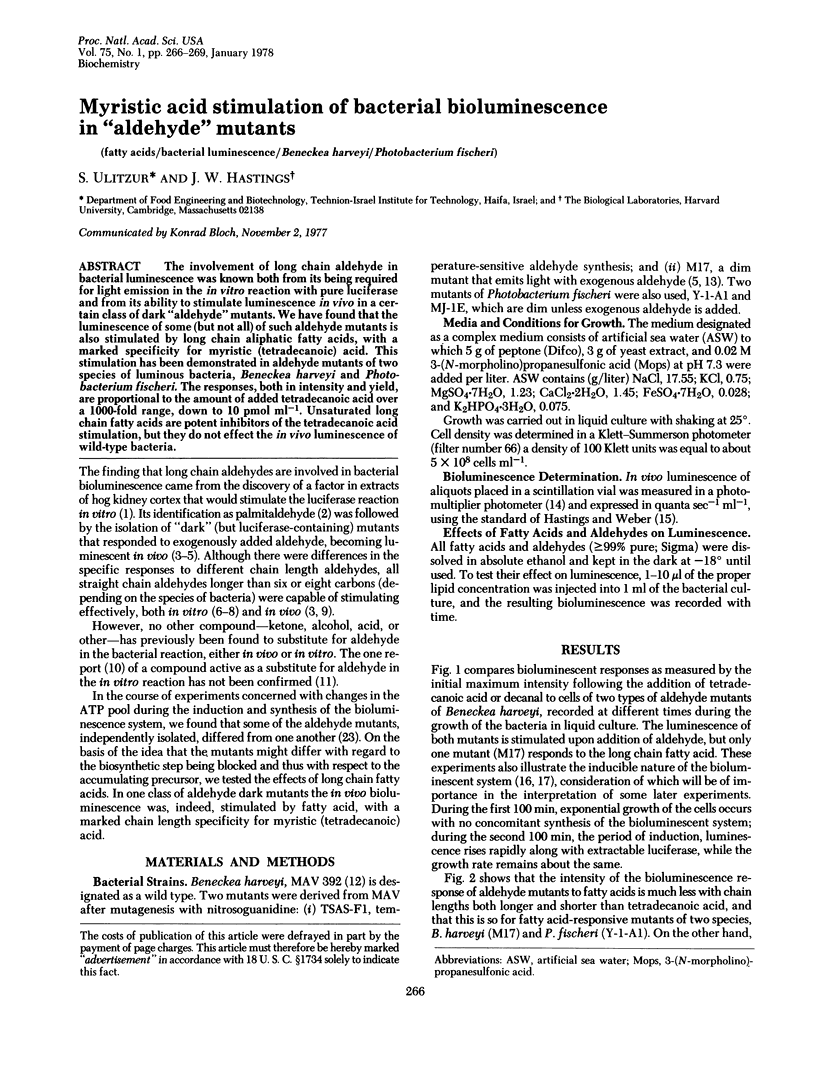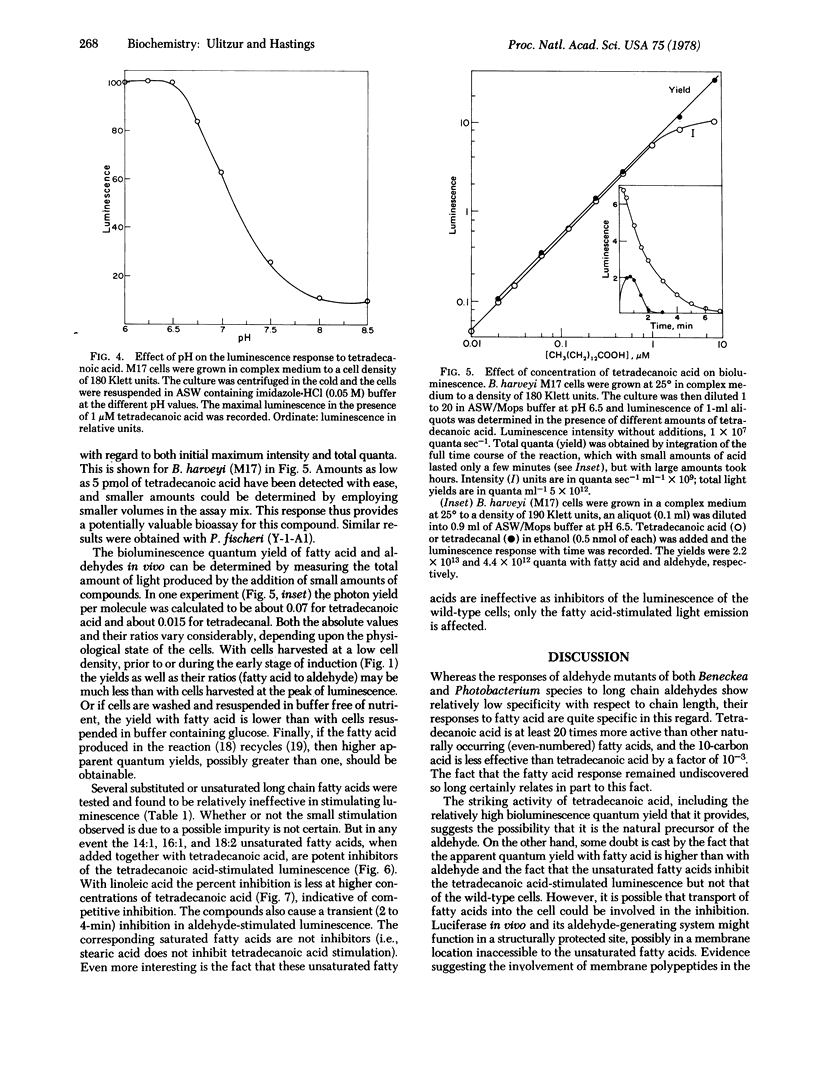Abstract
The involvement of long chain aldehyde in bacterial luminescence was known both from its being required for light emission in the in vitro reaction with pure luciferase and from its ability to stimulate luminescence in vivo in a certain class of dark "aldehyde" mutants. We have found that the luminescence of some (but not all) of such aldehyde mutants is also stimulated by long chain aliphatic fatty acids, with a marked specificity for myristic (tetradecanoic) acid. This stimulation has been demonstrated in aldehyde mutants of two species of luminous bacteria, Beneckea harveyi and Photobacterium fischeri. The responses, both in intensity and yield, are proportional to the amount of added tetradecanoic acid over a 1000-fold range, down to 10 pmol ml-1. Unsaturated long chain fatty acids are potent inhibitors of the tetradecanoic acid stimulation, but they do not effect the in vivo luminescence of wild-type bacteria.
Full text
PDF



Selected References
These references are in PubMed. This may not be the complete list of references from this article.
- Balakrishnan C. V., Langerman N. The isolation of a bacterial glycoprotein with luciferase activity. Arch Biochem Biophys. 1977 Jun;181(2):680–682. doi: 10.1016/0003-9861(77)90275-2. [DOI] [PubMed] [Google Scholar]
- Bentley D., Eberhard A., Solsky R. Decyl nitrite: an aldehyde analog in the bacterial bioluminescence reaction. Biochem Biophys Res Commun. 1974 Feb 27;56(4):865–868. doi: 10.1016/s0006-291x(74)80268-8. [DOI] [PubMed] [Google Scholar]
- Cline T. W., Hastings J. W. Bacterial bioluminescence in vivo: control and synthesis of aldehyde factor in temperature-conditional luminescence mutants. J Bacteriol. 1974 Jun;118(3):1059–1066. doi: 10.1128/jb.118.3.1059-1066.1974. [DOI] [PMC free article] [PubMed] [Google Scholar]
- Cline T. W., Hastings J. W. Mutationally altered bacterial luciferase. Implications for subunit functions. Biochemistry. 1972 Aug 29;11(18):3359–3370. doi: 10.1021/bi00768a008. [DOI] [PubMed] [Google Scholar]
- Cline T., Hastings J. W. Temperature-sensitive mutants of bioluminescent bacteria. Proc Natl Acad Sci U S A. 1971 Feb;68(2):500–504. doi: 10.1073/pnas.68.2.500. [DOI] [PMC free article] [PubMed] [Google Scholar]
- HASTINGS J. W., SPUDICH J., MALNIC G. THE INFLUENCE OF ALDEHYDE CHAIN LENGTH UPON THE RELATIVE QUANTUM YIELD OF THE BIOLUMINESCENT REACTION OF ACHROMOBACTER FISCHERI. J Biol Chem. 1963 Sep;238:3100–3105. [PubMed] [Google Scholar]
- Hastings J. W., Weber K., Friedland J., Eberhard A., Mitchell G. W., Gunsalus A. Structurally distinct bacterial luciferases. Biochemistry. 1969 Dec;8(12):4681–4689. doi: 10.1021/bi00840a004. [DOI] [PubMed] [Google Scholar]
- Mitchell G. W., Hastings J. W. A stable, inexpensive, solid-state photomultiplier photometer. Anal Biochem. 1971 Jan;39(1):243–250. doi: 10.1016/0003-2697(71)90481-7. [DOI] [PubMed] [Google Scholar]
- Ne'eman Z., Ulitzur S., Branton D., Hastings J. W. Membrane polypeptides co-induced with the bacterial bioluminescent system. J Biol Chem. 1977 Jul 25;252(14):5150–5154. [PubMed] [Google Scholar]
- Nealson K. H. Autoinduction of bacterial luciferase. Occurrence, mechanism and significance. Arch Microbiol. 1977 Feb 4;112(1):73–79. doi: 10.1007/BF00446657. [DOI] [PubMed] [Google Scholar]
- Nealson K. H., Markovitz A. Mutant analysis and enzyme subunit complementation in bacterial bioluminescence in Photobacterium fischeri. J Bacteriol. 1970 Oct;104(1):300–312. doi: 10.1128/jb.104.1.300-312.1970. [DOI] [PMC free article] [PubMed] [Google Scholar]
- Nealson K. H., Platt T., Hastings J. W. Cellular control of the synthesis and activity of the bacterial luminescent system. J Bacteriol. 1970 Oct;104(1):313–322. doi: 10.1128/jb.104.1.313-322.1970. [DOI] [PMC free article] [PubMed] [Google Scholar]
- ROGERS P., McELROY W. D. Enzymic determination of aldehyde permeability in luminous bacteria. I. Effect of chain length on light emission and penetration. Arch Biochem Biophys. 1958 May;75(1):87–105. doi: 10.1016/0003-9861(58)90400-4. [DOI] [PubMed] [Google Scholar]
- Rogers P., McElroy W. D. BIOCHEMICAL CHARACTERISTICS OF ALDEHYDE AND LUCIFERASE MUTANTS OF LUMINOUS BACTERIA. Proc Natl Acad Sci U S A. 1955 Feb 15;41(2):67–70. doi: 10.1073/pnas.41.2.67. [DOI] [PMC free article] [PubMed] [Google Scholar]
- STREHLER B. L., CORMIER M. J. Factors affecting the luminescence of cell-free extracts of the luminous bacterium, Achromobacter fischeri. Arch Biochem Biophys. 1953 Nov;47(1):16–33. doi: 10.1016/0003-9861(53)90434-2. [DOI] [PubMed] [Google Scholar]
- STREHLER B. L., CORMIER M. J. Isolation, identification, and function of long chain fatty aldehydes affecting the bacterial luciferin-luciferase reaction. J Biol Chem. 1954 Nov;211(1):213–225. [PubMed] [Google Scholar]
- Shimomura O., Johnson F. H., Kohama Y. Reactions involved in bioluminescence systems of limpet (Latia neritoides) and luminous bacteria. Proc Natl Acad Sci U S A. 1972 Aug;69(8):2086–2089. doi: 10.1073/pnas.69.8.2086. [DOI] [PMC free article] [PubMed] [Google Scholar]
- Shimomura O., Johnson F. H., Morise H. The aldehyde content of luminous bacteria and of an "aldehydeless" dark mutant. Proc Natl Acad Sci U S A. 1974 Dec;71(12):4666–4669. doi: 10.1073/pnas.71.12.4666. [DOI] [PMC free article] [PubMed] [Google Scholar]


